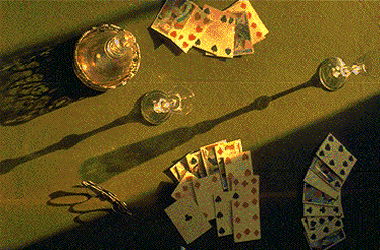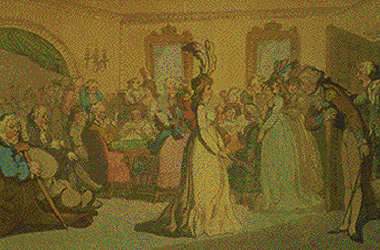Gambling at Bath

- Gambling at Bath
- [click on the picture to enlarge it]
Doctor prescribed gambling to their patients as a cure causing them to forget about their complaints; Lady Bristol wrote:
“The sight of Dr. Cheyne this morning renewed my affliction, but he had given something that has done me a vast deal of good, and I am to have a party at Ombre.”
(Hervey Letter-Books, 1721, II, 184).
“The truth is, the gaming table was properly the salutary font, to which such numbers flocked.”
(Goldsmith, Life of Nash, 1762, 23)
But some observers complained that the ladies’ tense facial expression at the gambling-table was prejudicial to their beauty:
“The great Gravity of the Countenance round Harrison’s Tables (the proprietor of the Old Assembly Rooms) puts me in Mind of a Council-Board (…) The Gamester ladies have surmounted the little Vanities of showing their Beauty, with violent Distortions, and wear away their Lillies and Roses in tedious Watching and restless Elucubrations.”
(Steele, Tatler 16, 17 May 1709)
Elizabeth Robinson (future Mrs. Montague), complained that men’s exclusive passion for gambling made them forget the ladies:
“But to my misfortune he likes the queen of Spades so much more than me, that never looks off his cards, though were I queen of Diamonds, he would stand a fair chance for me.”
(Letters 1740, I, 79).
In her description of the occupations of the day, she says that the only question heard I the morning was “How d’ye do?” (in the morning, the visitor would go to the pump-room) and in the afternoon “What’s trumps” since this was the moment for gambling.
(Letters, 1740, I, 73).
Elizabeth Giffard mentions card-playing in her diary.

- Card-playing
- Card-playing, by Rowlandson
[click on the picture to enlarge it]
The most widely practised games were “Ombre” (or “hombre”, man: a game of Spanish origin, for three players, played on a triangular tables), the basset, cribbage, and faro.
The stake would be composed of money or precious objects (snuff-boxes).
The Abbé Le Blanc considered that the English passion for gambling was due to their interest in calculations:
"Les Anglais se ruinent tous les jours aux Jeux de Hasard dont ils font leur principale étude, ils sont accoutumés à calculer les probabilités dépendant de la politique et du commerce. Ils calculent la probabilité de la vie, celle du retour des vaisseaux. Ils font des Annuités. Ils portent cette habitude dans le Jeu, les paris, les hasards.
(Lettres d’un Français, 1751, lettre LVXXI, 233)
Cards were taxed after 1711. Gambling based on figures was then forbidden by laws (1739, 1745), so that a new game was invented, “Evens and Odds” (E.O.) with letters instead of figures.
Sharpers were recognizable by their long cuffs in which they hid cards. They were described in Thomas Goulding’s play The Fortune-Hunter or the Gamester Reclaimed (1736) set supposedly at Aachen but in fact in Bath. Gambling gave rise to tragic events such as the fate of Fanny Braddock who after losing her fortune was used as a decoy by sharpers and hanged herself.
In the Assembly Rooms, the proprietors and Beau Nash had a percentage on the gains.
Once, Nash lost money and
“broke all the windows according to custom”
(Lady Bristol, 1721).
Wesley attempted to fight the taste for gambling during his 1739 visit, but his protests were thought exaggerated by Richard Graves, rector of Claverton near Bath in The Spiritual Quixote (1772).
Gambling was also practised in London.

